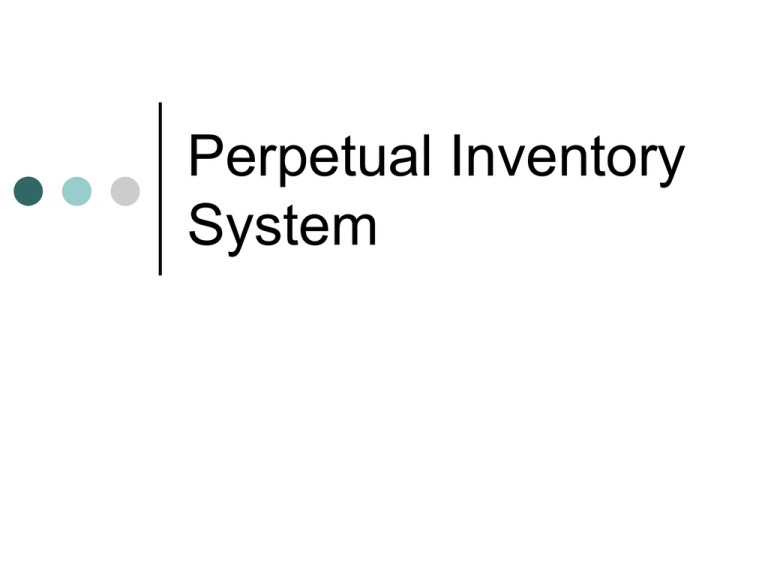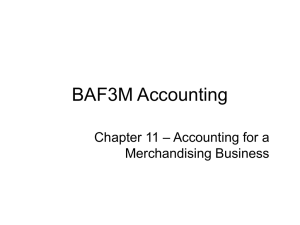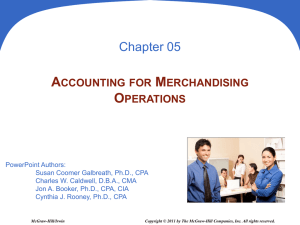File
advertisement

Perpetual Inventory System Perpetual Inventory Detailed record of items in stock is kept up to date on an ongoing basis As items sold, info. is transferred directly to store’s central computer which is programmed to make the appropriate deductions from the inventory and make accounting entries Sales returns are generally handled by separate department System cannot automatically know when goods are lost, stolen or broken; therefore have to do manual check of inventory Purchases When goods are purchased for resale, inventory account is immediately updated by the cost price of the merchandise. At any time, the business can look in the general ledger and see the book value of the inventory on hand. Remember -- this is the book value and may not be 100% accurate (damaged goods, theft, clerical errors, etc.). Merchandise Inventory (at Cost Price) 3800 Bank or A/P 3800 To record the Purchase of Inventory in Perpetual System Purchase Returns & Allowances Goods purchased may be damaged, defective, of inferior quality, or they may not meet purchaser’s specifications Goods may be returned or purchase price may be reduced (an allowance) Entry to record: Cash or Accounts payable 300 Merchandise Inventory (for amount of return or adjustment) 300 Quantity and Purchase Discounts Quantity discount: reduction in price due to the quantity being purchased Purchase discount: reduction in price due to early payment of amount due Entry to record: Accounts payable 3500 Merchandise Inventory (for amount of discount) 70 Cash 3430 Freight Costs Purchase agreement indicates when ownership of the goods is transferred from buyer to seller FOB Shipping Point: Buyer accepts ownership at place of shipping and pays for shipping costs Merchandise Inventory 150 Cash 150 FOB Destination: Buyer accepts ownership when goods are delivered to buyer’s place of business and seller pays freight costs Seller debits Freight Out for cost of shipping Summary of Purchases Merchandise Inventory (Purchase) May 4 (Freight) 4 3800 150 Bal. 3580 May 9 300 (Purchase Return) 14 70 (Purchase Discount) Sale of Merchandise (two journal entries needed) The first entry identifies the sale at the selling price. A second entry shows the merchandise going out of the business and the inventory account decreasing by the cost price of the goods (the price the business paid for the merchandise). Step 1 Bank or Accounts Receivable (at Selling Price) 3800 Sales (at Selling Price) 3800 To record the sale of merchandise in a perpetual system Step 2: Cost of Goods Sold (at cost price) 2400 Merchandise Inventory (at cost price) 2400 To record the inventory sold at cost price in a perpetual system Sales Taxes Collected by merchandising companies on the goods that they sell Periodically remitted to government Sales taxes collected are not revenue Treated as a liability until paid (as they are due to the government) recorded in HST Payable account Sales Returns & Allowances Sales returns: when customers return merchandise to seller for credit or refund Sales allowances: when seller grants customers a price reduction Seller’s entry required: Sales returns and allowances 300 Accounts receivable or cash 300 If merchandise returned, additional entry required: Merchandise inventory 140 (recorded at orig. cost) Cost of goods sold 140 To record cost of returned goods. Quantity and Sales Discounts Quantity discount: Reduction in selling price due to the volume of goods purchased Sale is recorded at reduced price Sales discount: Discount offered for early payment of bill Discount amount taken is debited to Sales Discounts (a contra revenue account) Original amount in Sales is not changed Journal Entry Cash 3430 Sales Discount 70 Accounts Receivable 3500 To record collection of invoice #731 within discount period Summary of Sales Transactions Sales May 4 3800 Sales Discounts May 14 70 Sales Returns & Allowances May 9 300 Cost of Goods Sold May 4 2400 May 9 140 Bal. 2260 COGS Cost of beginning inventory + cost of goods purchased = Cost of goods available for sale – cost of ending inventory = cost of goods sold i.e.42500+143000=185500-36400 = 149100 COGS Calculation is completed after each sale Completing the Accounting Cycle Same types of adjusting entries as a service company One additional adjustment for inventory A physical count is an important control feature To ensure the recorded inventory amount agrees with the actual quantity on hand A perpetual system indicates what should be there An inventory count will determine what exists Additional accounts to be closed: Sales, Sales Returns and Allowances, Sales Discounts, Cost of Goods Sold, Freight Out Merchandise Inventory Inventory counted at fiscal year-end It becomes the beginning inventory figure for the next fiscal period If the amount on hand is different than what is displayed in the merchandise inventory account, an adjustment needs to be made Adjusting Entry Cost of Goods Sold 500 Merchandise Inventory 500 To record difference between inventory records and physical units on hand. Financial Statements Merchandisers use the classified balance sheet Two forms of income statements are widely used: multiple-step and single-step Multiple-Step Income Statement Five main steps: 1. Net Sales 2. Gross Profit 3. Income from Operations 4. Non-operating Activities (interest, dividend revenue, gains from sale of property, interest expense, losses) 5. Net Income Multiple-Step Income Statement H IGH P OIN T E LE CT R ON IC Inc o m e S ta te m e nt Y e a r E nd e d M a y 31, 2008 Calculation of Net sales and Gross profit Calculation of Income from operations Calculation of Non-operating activities and Net income Sales revenue Sales Less: Sales returns and allowances Sales discounts Net sales Cost of goods sold Gross profit Operating expenses Salaries expense Rent expense Utilities expense Advertising expense Amortization expense Freight out Insurance expense Total operating expenses Income from operations Other revenues Interest revenue Gain on sale of equipment Total non-operating revenue and gain Other expenses Interest on expense Casualty loss from vandalism Total non-operating expense and loss Net non-operating revenue Net income $ $ $ 16,700 4,300 480,000 21,000 459,000 315,000 144,000 45,000 19,000 17,000 16,000 8,000 7,000 2,000 114,000 30,000 $ 3,000 600 3,600 $ 1,800 200 2,000 $ 1,600 31,600 Single-Step Income Statement HIGHPOINT ELECTRONIC Income Statement Year Ended May 31, 2008 Revenues Net sales Interest revenue Gain on sale of equipment Total Revenues Expenses Cost of goods sold Operating expenses Interest expense Casualty loss from vandalism Total expenses Net income $459,000 3,000 600 462,600 $315,000 114,000 1,800 200 431,000 $ 31,600 All data are classified as either (1) revenues or (2) expenses Classified Balance Sheet H IGH POIN T ELECT R ON IC Ba la nc e She e t (p a rtia l) Ma y 31, 2008 Assets Current assets Cash Accounts receivable Merchandise inventory Prepaid insurance Total current assets Property, plant, and equipment Store equipment Less: Accumulated amortization Total assets $ $ 80,000 24,000 9,500 16,100 40,000 1,800 67,400 56,000 $ 123,400 Merchandise Inventory reported as a current asset following Accounts Receivable Gross Margin Ratio The relation between sales and COGS Gross Margin/Net Sales = Gross Margin Ratio i.e. (in millions) $645.1 /$1396.5 = 46.2% Means that each $1 of sales yields about 46.2 cents in gross margin to cover all other expenses








